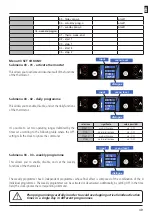
41
EN
Smoke discharge
The discharge system must be for the stove only (it
is not permissible to discharge into fl ues in common
with other devices). The smoke discharge takes place
through the 8 cm. A “T” with a condensation collection
cap should be provided. The smoke discharge of
the stove must be connected with the outside using
a steel or black tube (resistant up to 450°C) without
obstructions.
The tube must be hermetically sealed. To make the
tubes airtight and for their eventual insulation, it is
necessary to use material resistant up to at least 300°C
(silicone or putty for high temperatures).
The horizontal sections can be up to 2 m long. It is
possible to have up to three 90° curves. If the discharge
tube does not insert in the fl ue, an opportunely
fastened vertical section of at least 1.5 m is necessary
(except for evident safety contraindications) and a
windproof termination (Fig.3). The vertical duct can be
inside or outside. If the smoke duct is outside it must
be insulated (Fig.4). If the smoke duct is inserted in a
fl ue, this must be certifi ed for solid combustibles and
if it is larger than 150 mm in diameter, modifi cation is
necessary by inserting a tube and sealing the discharge
with respect to the parts in brickwork.
It must be possible to inspect all the sections of the
smoke duct. If it is a fi xed duct it must have openings
for inspection and cleaning.
External air intake
The stove must be furnished with the air necessary to
guarantee the regular functioning of the combustion
and an environmental well being.
• Be sure that the room where the stove is installed has
suffi cient aeration and, if necessary, install an air intake
duct with a minimum recommended diameter of 50 mm
to bring in air from the outside.
• The external air intake must communicate with the
stove and positioned so that it is not obstructed. It
must be protected with a permanent non-closable grill
or other suitable protection provided that the minimum
diameter is not reduced.
• The air fl ow can also be acquired from a locale adjacent
to where the stove is installed as long as that fl ow can
freely cross the permanent non-closable openings that
communicate with the outside.
• The presence in the local adjacent to where the stove
is installed, of other devices in use or of suction devices
that cause a contrary draught effect must not create
a lower air pressure in the locale than in the outside
environment.
• In the adjacent locale the permanent openings must
respond to the requisites which are listed in the points
above.
A. Smoke discharge
A
A
A
B
B
A. Horizontal air duct
B.Vertical air duct
A. Horizontal air duct
B. Discharge of smoke
According to the norm UNI
10683/98, the stove must not be
in the same environment where
extractors, type B gas devices or
in any case, devices that create lower
atmospheric pressure in the locale are
found.
Содержание QUADRA 12D
Страница 1: ...USER MANUAL QUADRA 12D...
Страница 24: ...54 EN...
Страница 33: ...63 EN NOTES Cod 001109...
Страница 34: ...64 EN NOTES Cod 001109...


























